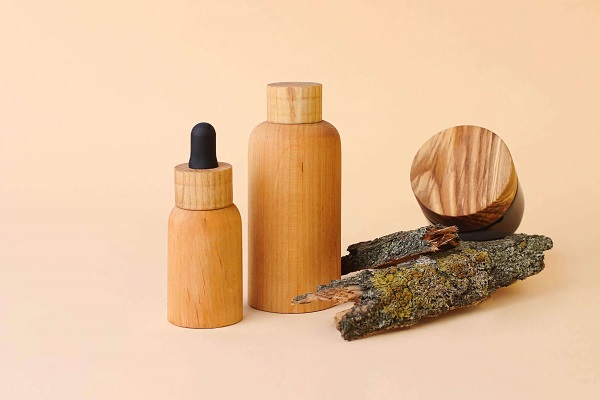Learn to write and develop effective Likert scale questions for your market research using tips from this best practice guide, especially useful for concept validation.
Here are some tips and tricks for great Likert scale questions
1. Write Clear Questions
Likert questions should be phrased as factually and specifically as possible to encourage more accurate results. Remember, respondents will only answer the exact question that they are asked.
Consider a customer satisfaction survey. The question “How satisfied are you with this product?” could receive significantly different answers than if you asked, “How satisfied are you with the price of this product?" For this reason, it is important to acknowledge which aspect you are seeking feedback on, e.g. overall satisfaction, price, value, effectiveness, packaging, leaving no room for individual interpretation.
2. Keep Adjectives Consistent
Pay close attention to the use of adjectives in Likert questions to ensure that respondents can clearly understand the meaning of each option. Each adjective should have a clear position on the scaling, from highest to lowest. Use “Extremely” for both ends of the scale (e.g. “Strongly agree” “Strongly disagree”, set a neutral midpoint (e.g. “Neither agree nor disagree”), and fill moderate ratings with the same adjectives (e.g. “Somewhat disagree”, “Somewhat agree”).
3. Consider Unipolar vs. Bipolar Scale
According to the Knowledge Base, Likert scales are always unidimesional (i.e. they measure a single dimension of something). But they can be either bipolar or unipolar, i.e. they have either two ends or one:
Use bipolar scales when you want respondents to answer on either a positive or negative side of neutrality. For example, the question “How likely are you to purchase this product” would range from “Extremely Unlikely” to “Extremely likely” with “Undecided” as the midpoint.
Unipolar scales are easier for respondents to follow, operating from a scale of zero to extreme. For example, the question “How appealing does this product look to you?” could have options ranging from “Not appealing at all” to “Extremely appealing”.
4. Use Questions Rather Than Statement
To avoid acquiescence bias (AKA ‘Yes’ bias) caused by respondents’ tendency to answer questions agreeably or positively. Question-wording plays a significant role in how your respondents will answer a question, so you should be mindful of phrasing Likert questions. Be mindful of language – avoid leading questions and opt for open-ended questions instead. For example, asking “How much do you agree with the following statement: “I am satisfied with the quality of this product”?” is more likely to encourage a biased response than “How satisfied are you with the quality of this product?”
Other tips
Use flip scales. Flip scales obtain more accurate survey responses by preventing bias. Instead of displaying all answer options in ascending order (e.g. 1 = very dissatisfied, 5 = very satisfied), you can use a flip scale for some questions to avoid repetition (e.g. 1 = very satisfied, 5 = very dissatisfied).
Seek diverse answers. A good Likert question should produce a broad range of answers. Whilst it may seem favourable for everybody to agree your product is perfect, you will be missing out on valuable feedback from consumers about areas for improvement.
Review your questions. Ask others to read through your questions and grade them before launching your study to ensure the phrasing is clear and to check for any spelling or grammar mistakes. You should also keep your tone lively and avoid repetitive language to keep respondents engaged.
Likert Scale Question Types & Examples
A lot of Likert scale questions are already loaded into the Conjointly question library. Here are some useful examples you can use for inspiration:
Customer satisfaction surveys
Example 1: How satisfied were you with your stay at our hotel?
- Very dissatisfied.
- Somewhat dissatisfied.
- Neither satisfied nor dissatisfied.
- Somewhat satisfied.
- Very satisfied.
Example 2: Which image best describes your experience with our product?
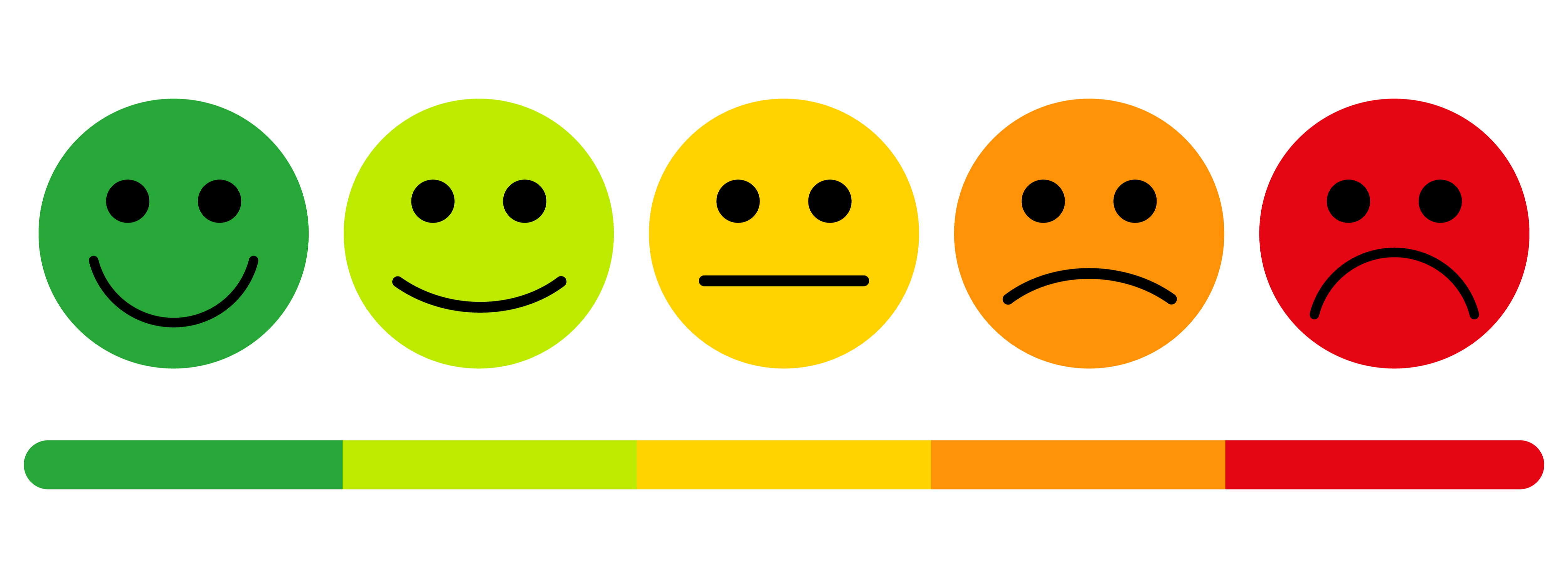
Example 3: How well does this product meet your needs?
- It did not meet my needs at all.
- It met very few of my needs.
- It met some of my needs.
- It met the majority of my needs.
- It met all of my needs.
Example 4: How intuitive did you find using/ navigating our website?
- Not intuitive at all.
- Not very intuitive.
- Somewhat intuitive.
- Mostly intuitive.
- Extremely intuitive.
Frequency of behaviours
Example 1: In the last seven days, how often have you read articles (e.g. news, reviews, etc.) on your phone vs in a physical newspaper?
- Much less on phone than in a newspaper.
- Moderately less on phone than in a newspaper.
- About the same.
- Moderately more on phone than in a newspaper.
- Much more on phone than in a newspaper.
Example 2: When shopping for groceries in the last six months, how often did you pay with cash?
- Never.
- Rarely.
- Sometimes.
- Usually.
- Always.
Example 3: How often did you use public transportation during a regular week before COVID-19?
- Never.
- 1 to 2 days a week.
- 3 to 4 days a week.
- 5 days a week.
- 6 to 7 days a week.
Agreement statements
Example 1: Please select how much you agree or disagree with the following statement: Cats make better pets than dogs.
- Strongly disagree.
- Somewhat disagree.
- Neither agree nor disagree.
- Somewhat agree.
- Strongly agree.
Example 2: On a scale of 1 to 5, how strongly would you agree or disagree with the following statement: Chocolate ice cream tastes better than vanilla ice cream.
- Strongly disagree.
- Somewhat disagree.
- Neither agree nor disagree.
- Somewhat agree.
- Strongly agree.
Example 3: Please select the option which most accurately reflects your agreement/disagreement about the following statement: I enjoy long walks on the beach.
- Strongly agree.
- Somewhat agree.
- Neither agree nor disagree.
- Somewhat disagree.
- Strongly disagree.
Example 4: Please indicate how strongly you agree or disagree with the following statement: I like eating chocolate more than bananas.
- Strongly agree.
- Somewhat agree.
- Neither agree nor disagree.
- Somewhat disagree.
- Strongly disagree.
Product assessments
Attractiveness
Example 1: On a scale of 1 to 5, how attractive do you find the following product?
- Not at all attractive.
- Slightly attractive.
- Moderately attractive.
- Very attractive.
- Extremely attractive.
Example 2: On a scale of 1 to 5, how attractive do you think other people will find this product?
- Not at all attractive.
- Slightly attractive.
- Moderately attractive.
- Very attractive.
- Extremely attractive.
Example 3: On a scale of 1 to 5, how attractive is the new product compared to the old product?
- The new product is much less attractive than the older product.
- The new product is slightly less attractive than the older product.
- The new product is neither more nor less attractive than the older product.
- The new product is slightly more attractive than the older product.
- The new product is much more attractive than the older product.
Example 4: On a scale of 1 to 5, how attractive is the packaging of the following product?
- Not attractive at all.
- Slightly attractive.
- Moderately attractive.
- Very attractive.
- Extremely attractive.
New and different
Example 1: On a scale of 1 to 5, how novel do you believe this product is, compared to other soft drinks products in the market?
- It is not novel at all.
- It is slightly novel.
- It is moderately novel.
- It is very novel.
- It is extremely novel.
Example 2: On a scale of 1 to 5, how innovative would you say this product is, compared to other available soft drinks products in the market?
- It is not innovative at all.
- It is slightly innovative.
- It is moderately innovative.
- It is very innovative.
- It is extremely innovative.
Example 3: On a scale of 1 to 5, how inventive is this product in terms of its flavour, compared to other available soft drinks products in the market?
- It is not inventive at all.
- It is slightly innovative.
- It is moderately innovative.
- It is very innovative.
- It is extremely innovative.
Unique
Example 1: On a scale of 1 to 5, how distinctive are the features of this product, compared to other similar products on the market?
- They are not distinctive at all.
- They are slightly distinctive.
- They are moderately distinctive.
- They are very distinctive.
- They are extremely distinctive
Example 2: On a scale of 1 to 5, how special do you think this product is, compared to other products?
- I don’t think this product is special at all.
- I think this product is slightly special.
- I think this product is moderately special.
- I think this product is very special.
- I think this product is extremely special.
Example 3: On a scale of 1 to 5, how personalised do you think this product is, compared to other products?
- This product doesn’t look personalised at all.
- This product feels slightly personalised.
- This product feels moderately personalised.
- This product feels very personalised.
- This product feels extremely personalised.
Low cost
Example 1: On a scale of 1 to 5, how affordable do you find this product, compared to other similar products in the market?
- I think this product is very expensive.
- I think this product is somewhat expensive.
- I think this product is a moderate price.
- I think this product is somewhat cheap.
- I think this product is very cheap.
Example 2: On a scale of 1 to 5, how reasonably priced do you think this product is compared to other similar products?
- This product is not a reasonably price at all.
- This product is a slightly reasonable price.
- This product is a moderately reasonable price.
- This product is a very reasonably price.
- This product is an extremely reasonably price.
Example 3: On a scale of 1 to 5, do you think this product is good value for money?
- I do not think this product is good value for money at all.
- I think this product is slightly good value for money.
- I think this product is moderately good value for money.
- I think this product is very good value for money.
- I think this product is extremely good value for money.
Reliable
Example 1: On a scale of 1 to 5, how reliable do you think a product with this statement is, compared to other products in the market?
- Not at all reliable.
- Somewhat unreliable.
- Moderately reliable.
- Very reliable.
- Completely reliable.
Example 2: On a scale of 1 to 5, how would you rate the trustworthiness of a product with this statement?
- Not trustworthy at all.
- Slightly trustworthy.
- Moderately trustworthy.
- Very trustworthy.
- Completely trustworthy.
Example 3: On a scale of 1 to 5, how dependable do you think the new SmartWatch is?
- Not at all dependable.
- Slightly dependable.
- Moderately dependable.
- Very dependable.
- Completely dependable.
Aligned with personal values
Example 1: On a scale of 1 to 5, how well does this product fit into your vegetarian diet?
- It does not fit my diet at all.
- It slightly fits into my diet.
- It moderately fits into my diet.
- It fits very well into my diet.
- It fits perfectly into my diet.
Example 2: How environmentally friendly do you think this product is?
- Very harmful to the environment.
- Harmful to the environment.
- No impact on the environment.
- Beneficial to the environment.
- Very beneficial to the environment.
Example 3: On a scale of 1 to 5, how useful would this product be in helping you build your career?
- Not useful at all.
- Slightly useful.
- Moderately useful.
- Very useful.
- Extremely useful.
Technologically advanced
Example 1: On a scale of 1 to 5, how advanced is the technology in this product?
- The technology is not advanced at all.
- The technology is slightly advanced.
- The technology is moderately advanced.
- The technology is very advanced.
- The technology is extremely advanced.
Example 2: On a scale of 1 to 5, how modern do you believe this product is, compared to available products on the market?
- Not at all modern.
- Slightly modern.
- Moderately modern.
- Very modern.
- Extremely modern.
Example 3: On a scale of 1 to 5, how innovative do you feel the FacialScan(™) technology is in this laptop?
- Not very innovative.
- Slightly innovative.
- Moderately innovative.
- Very innovative.
- Extremely innovative.
FAQs
What is a Top-2-Box (T2B)?
A top-2-box score summarises positive responses from a Likert scale survey question, making it faster to interpret results.
Looking at the raw output from a Likert scale question, it can be hard to quickly identify which options are the most preferred.
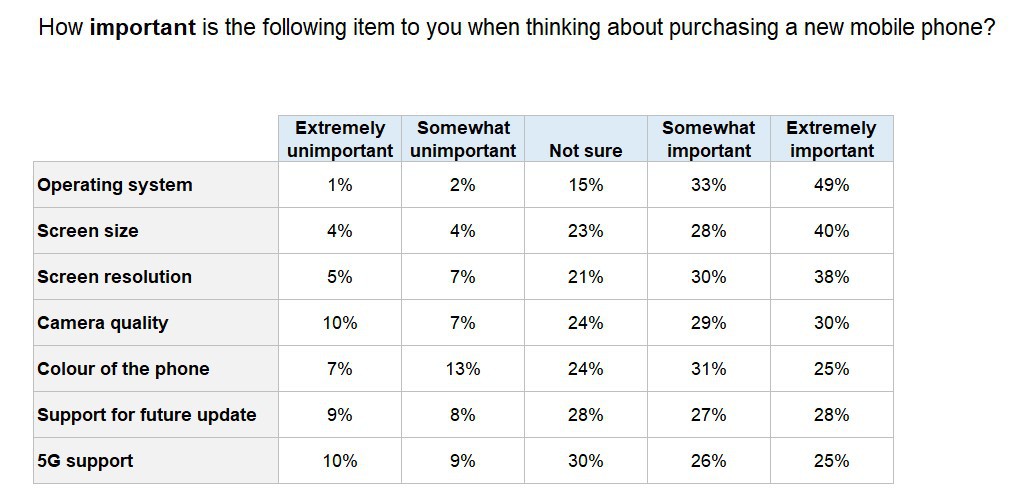
The top 2 box score represents the proportion of respondents that selected either of the top 2 responses of the scale. We see in this example, “Somewhat important” and “Extremely important” are the top two options.
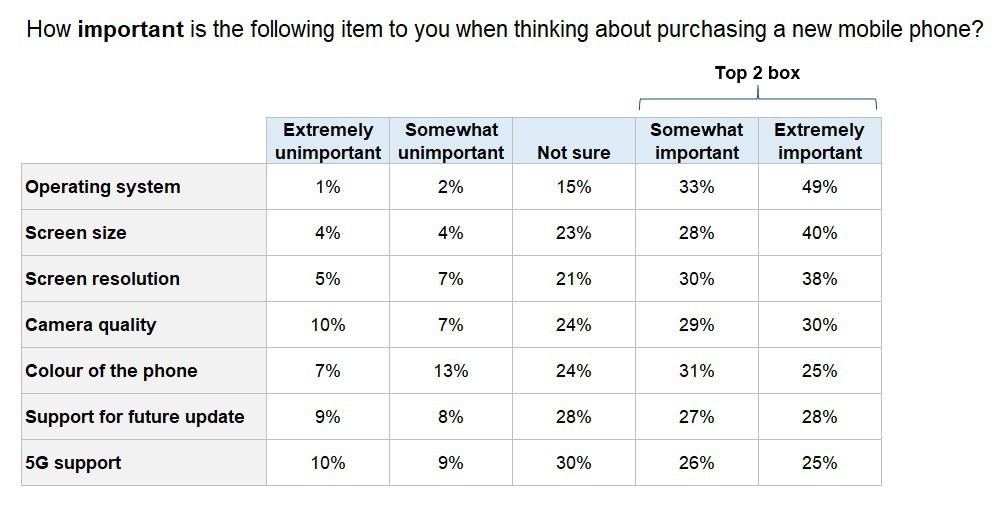
The top 2 box score can be calculated as the percent of respondents that chose either of the top two options.
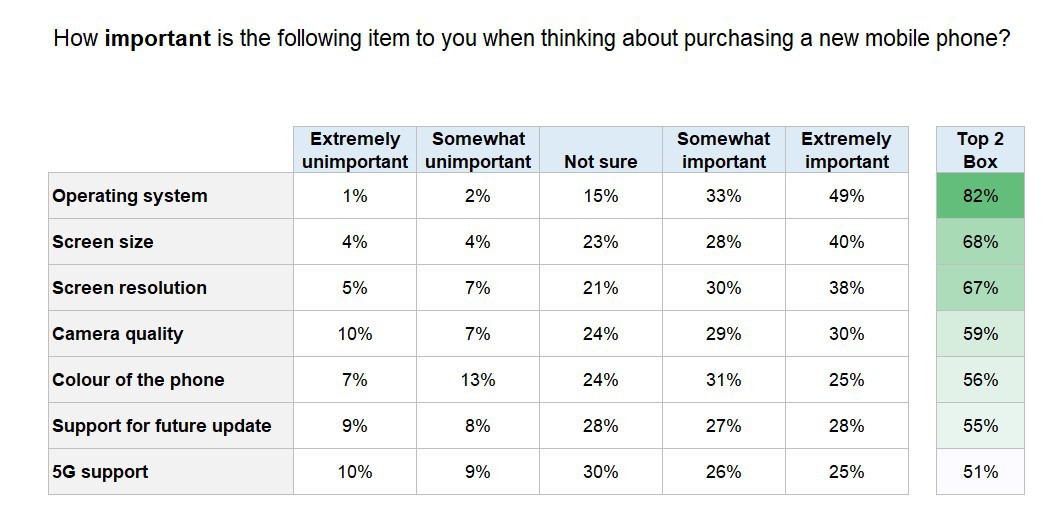
While the top 2 box score is often used for 5-point Likert scale questions, different variations can also be used, such as the top 3 box for a 7-point Likert scale question.


